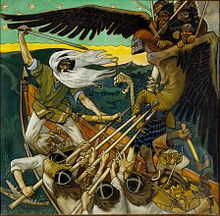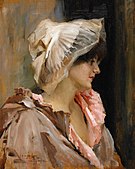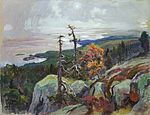As as great fan of all Andrew Graham-Dixon's TV programmes & documentaries I thought that first part of Scandinavian Art was brilliant shown on BBC2 14/3/2016.
I am hopeful that very interesting, remarkable and often symbolic Finnish art gets mentioned in the series later.
Geographically, the Scandinavian Peninsula includes what is today mainland Sweden and mainland Norway. A small part of northwestern Finland is sometimes also considered part of the peninsula. In physiography, Denmark is considered part of the North European Plain, rather than the geologically distinct Scandinavian Peninsula mainly occupied by Norway and Sweden. However, Denmark has historically included the region of Scania on the Scandinavian Peninsula.(New World Encyclopedia )
We have had a freedom of movement (no passports needed) between Finland, Sweden, Norway and Denmark since 1954.Between Iceland since 1955 and since1966 with the Faroe Islands.The Nordic Council which is geo-political and inter-parliamentary forum for co-operation the Nordic countries was founded 1952. The Nordic Countries have their respective histories but we are interwined in many ways.
Around 800AD is Viking period and affecting Finland. People from Kainuu ( = Pohjanmaa ) area are known to go on battle trips to Norway robbing and raiding.
1154AD Arabic scientist Al-Idrisi writes that Finnish (Fymark) king owns land in Norway.1200AD Saxo Grammaticus, Danish historian, also writes about Finnish kings.1202 the Danes try to invade Finland.
Some quick notes on remarkable Finnish art.
I am here flying a Finnish flag as we were part of Sweden over 700 years.1809 Tsar Alexander I attacks Finland and Finland becomes an autonomous Grand Duchy of Russia.Finland became independent 1917.Sweden has alwayas had a great influence on Finnish art.Many of our talented painters and artists studied in Stockholm and Paris on the 17th and 18th century.The Finnish composer Jean Sibelius and painter Akseli Gallen-Kallela were passionate about Finland's independence and it was heard and seen in their works of art; many powerful ones based on the national epoc Kalevala.There are many more artists that can be named for their work.
Today Finnish design and architecture are doing well, always looking forward to new ideas and inventions.





Today Finnish design and architecture are doing well, always looking forward to new ideas and inventions.
Akseli Gallen-Kallela 1865-1931
The Aino Triptych 1891
The Defence of Sampo 1896
Lemminkäinen's Mother 1897
Symposion, painting by Gallen-Kallela - heavy drinking artists Jean Sibelius on the right
Albert Edelfelt 1854-1905
Christ and Mary Magdalene Parisien Lady Summer Two women with laundry
Pekka Halonen 1865-1933



In the sauna 1925 Washing in the ice 1900 Autumn landscape 1914
Eero Järnefelt 1863-1937
Burning the brushwood 1893 View of Koli 1935 Portrait of Saimi his wife
Alexander Laureus 1783-1823
Portraits of artist's stepmother Mariana Juliana Winqvist and her two sons by Aleksander Lauréus
Helena Sofia Schjerfbeck 1862-1946
Self portrait 1915 Family heirlooms 1916
Ferdinand von Wright 1822-1906
View from Lugnet 1899 The Fighting Capercaillies 1886
Magnus von Wright 1805-1868


Annankatu Helsinki Beach of Lehtisaari
Wilhelm von Wright 1810-1887



















